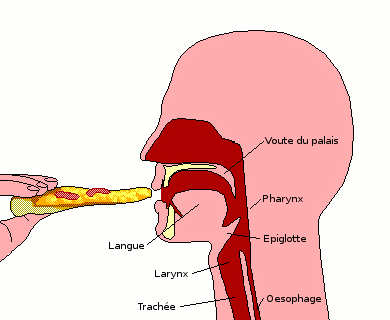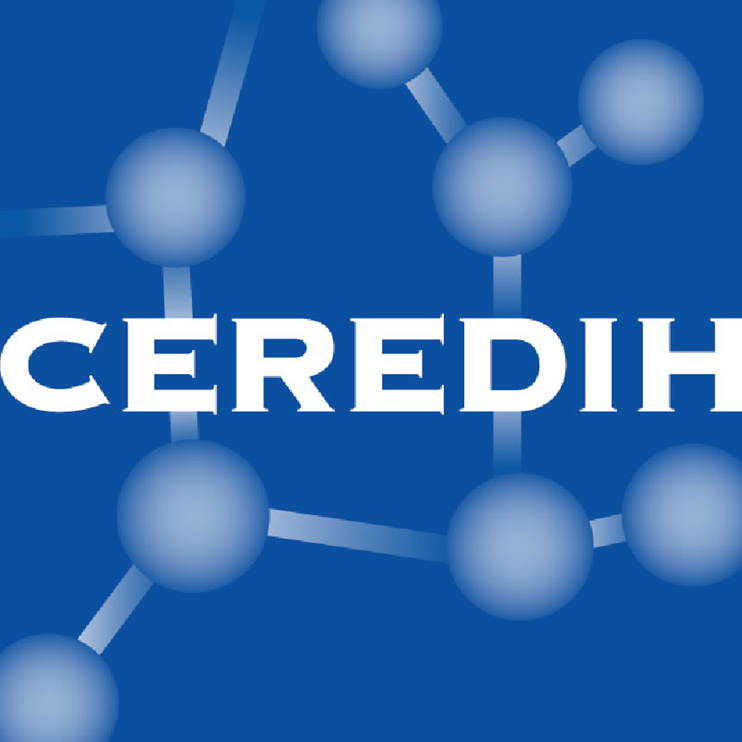Over time, swallowing becomes a source of difficulties for people with AT.
In addition to efforts that feeding demand, the risks are choking and inadequate nutritional intake.
Adaptive techniques and rehabilitation can minimize these problems.
Feeding involves:
- bringing food to mouth
- swallowing
In the picture of the Ataxia Telangiectasia may appear swallowing disorders, that is to say, the ability to swallow food, liquids or even his own saliva. This difficulty is clearly part of neurodegenerative disorders (see "Body control") and appears only progressively.
Swallowing
Man swallows approximately 600 times per day. There are three phases in swallowing:
 Phase 1 : in the mouth
Phase 1 : in the mouth
Phase 1: in the mouth The oral stage is the preparation for swallowing. Mixed with saliva, food is crushed to be better swallowed.
Phase 2 : in the throat
When swallowing starts, a sequence of very fast muscle contractions (<1s) implements and involves:
- the tongue/li>
- the vault of the palate
- the epiglottis
- the pharynx
- the larynx (vocal cords)
- a muscle at the top of the esophagus
Phase 3 : in the esophagus
The esophagus carries food crushed and mixed with saliva to the stomach and it must empeach it to get back.
Problems by phases
Each phase is characterize by a particular problem but once again, they aren't necessarily simultaneous. They are:
Phase 0: before reaching the mouth
Being able to bring food to the mouth. What seems elementary quickly becomes a source of fatigue with a neurodegenerative syndrome. Some simple solutions can facilitate this step.
Phase 1 : in the mouth
Leaks from the mouth: during chewing, it may not be sealed by the lips and the ability to keep a piece of food which attempts to escape may be lost. Difficulty chewing: length to form a ball capable of being swallowed = fatigue.
Phase 2 : in th throat
Particularly among adolescents with AT: problems of coordination in the swallowing sequence. This leads to silent wrong ways without reflexes such as coughing or retching heart to clear the airway of food who want to intrude. Moreover, these body reflexes also give warning of a problem to the entourage who can react quickly...but in AT, on warnings! The wrong ways, ie the content of the mouth that goes to the lungs instead of the esophagus are favored, even dangerous, which can increase the ENT and pulmonary infections.
Phase 3 : In the esophagus
Stomach reflux: acid reflux is usually not pleasant, but in AT, the major risk is the wrong way with a very aggressive stomachal liquid. In the same way as gastroesophageal reflux disease in young children, the fact of introducing foreign objects into the path to the lungs can cause lung infections, still complicated for AT patients.
Risks
Swallowing mouth control problems can cause:
- Respiratory infections
- risk of suffocation by silent wrong ways
- deficiencies in essential nutrients that were not absorbed in sufficient quantity
- salivation sometimes important for children with AT, saliva escaping sometimes.
Treatment
This is a specialty ofSLP (Speech and Langage Pathologist to treat this problem. Looking at drugs, beta blockers have sometimes been used, but with mixed results.






